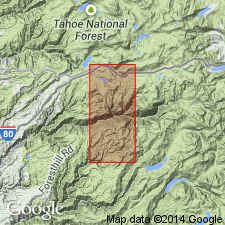
- Usage in publication:
-
- Barney Cavanah Ridge Formation*
- Modifications:
-
- Original reference
- Dominant lithology:
-
- Slate
- Quartzite
- AAPG geologic province:
-
- Sierra Nevada province
Summary:
Barney Cavanah Ridge Formation. These rocks previously referred to informally as the Lawton terrane (Schweickert and others, 1984) and the melange of Deep Canyon (Harwood, 1988). Consists of hematite-rich purple slate and thin-bedded quartzite that contains zones of broken quartzite and pelite with blocks of chert, quartz-granule conglomerate, and massive orthoquartzite. Total thickness is unknown; maximum exposed thickness ranges to 1,500 m. Overlies the Big Valley Bluff Formation (new); structurally underlies the chert and chert-argillite units of the Duncan Peak allocthon. Age is Ordovician(?) to Devonian(?) based on regional stratigraphic relationships.
Named from exposures on west slope of Barney Cavanah Ridge [in sec. 16, T. 15 N., R. 13 E., Duncan Peak 7.5-min quadrangle], Placer Co., northern CA.
Reference locality: on west slope of knob containing the VABM Lawton, in sec. 14, T. 16 N., R. 12 E., [Cisco Grove 7.5-min quadrangle, Placer Co., Tahoe National Forest, northern CA].
Source: Modified from GNU records (USGS DDS-6; Menlo GNULEX).
For more information, please contact Nancy Stamm, Geologic Names Committee Secretary.
Asterisk (*) indicates published by U.S. Geological Survey authors.
"No current usage" (†) implies that a name has been abandoned or has fallen into disuse. Former usage and, if known, replacement name given in parentheses ( ).
Slash (/) indicates name conflicts with nomenclatural guidelines (CSN, 1933; ACSN, 1961, 1970; NACSN, 1983, 2005, 2021). May be explained within brackets ([ ]).

